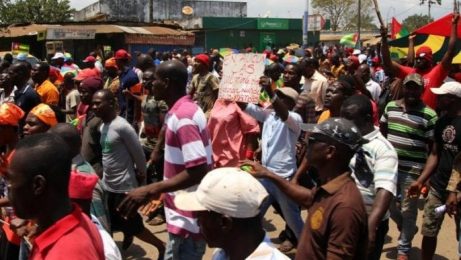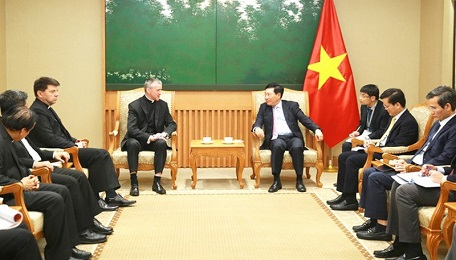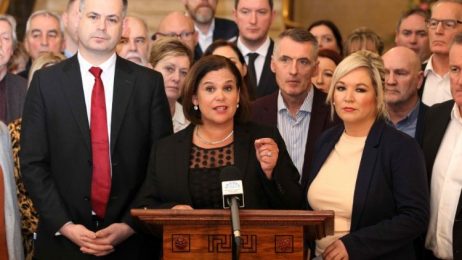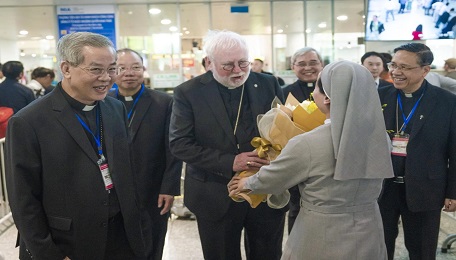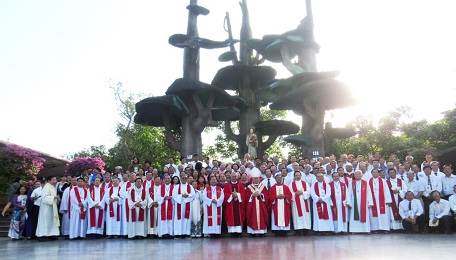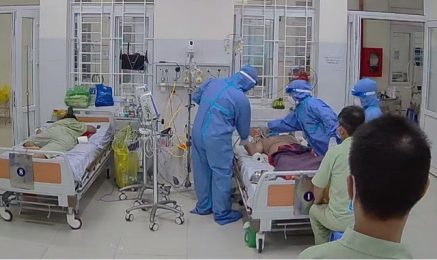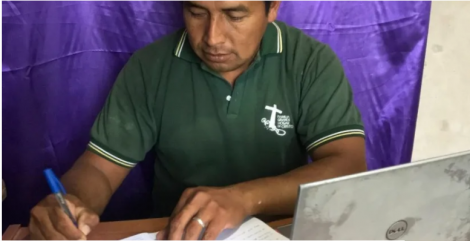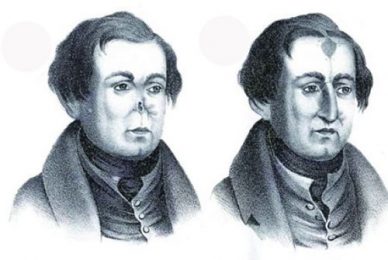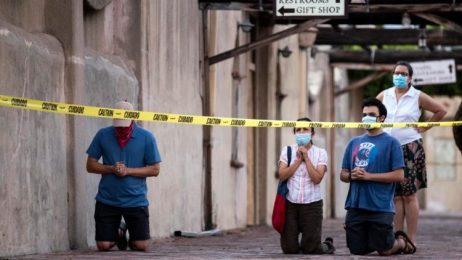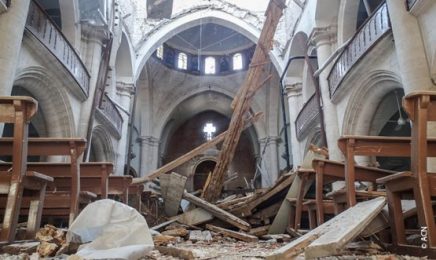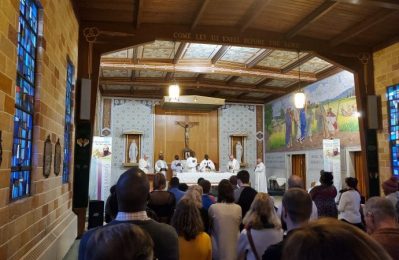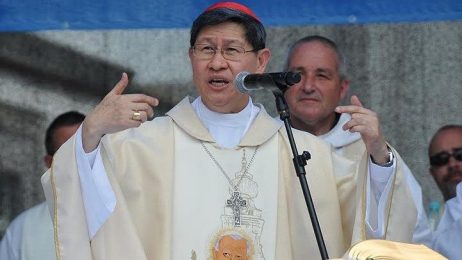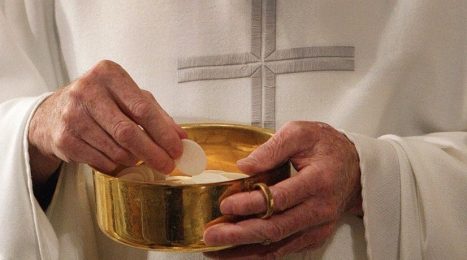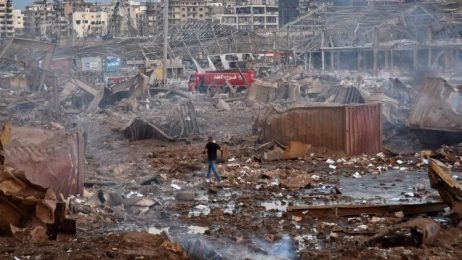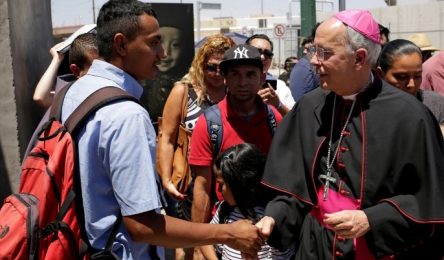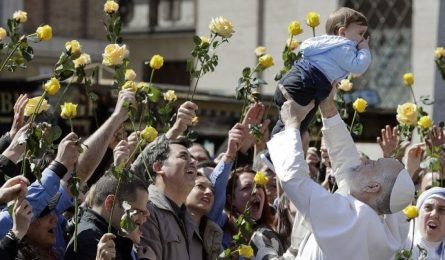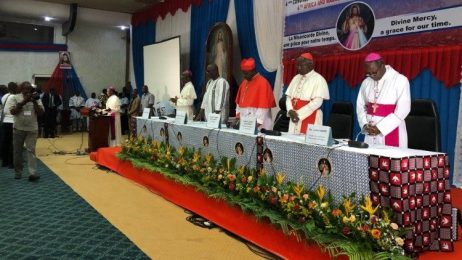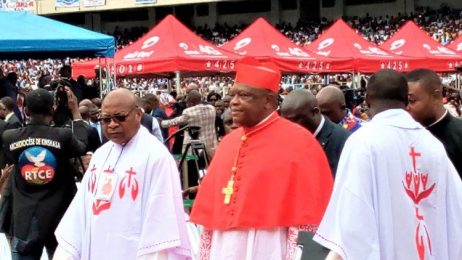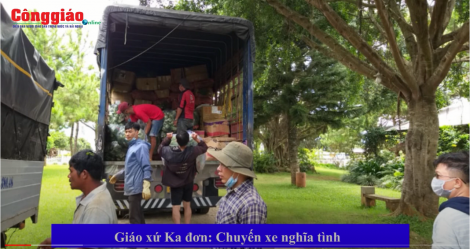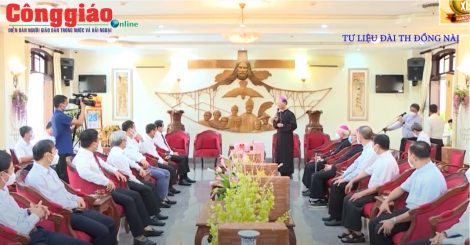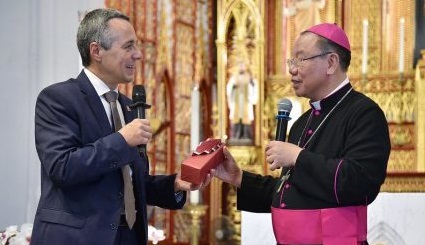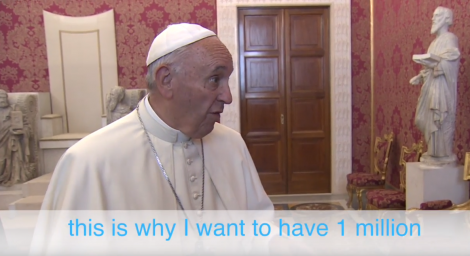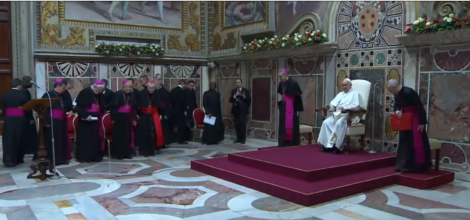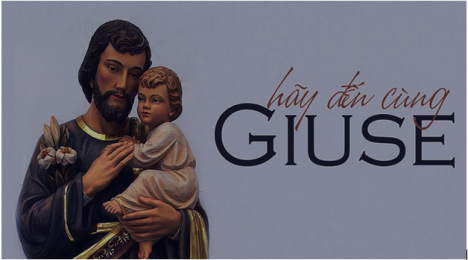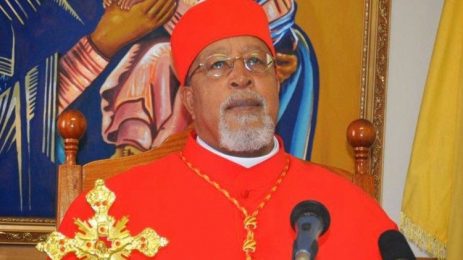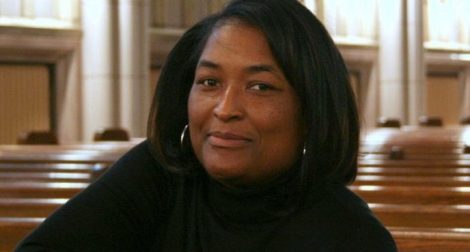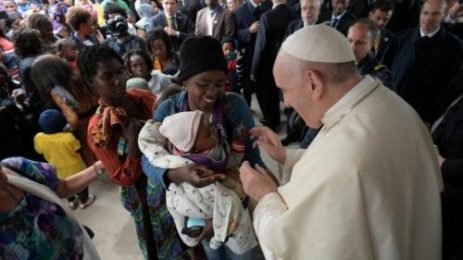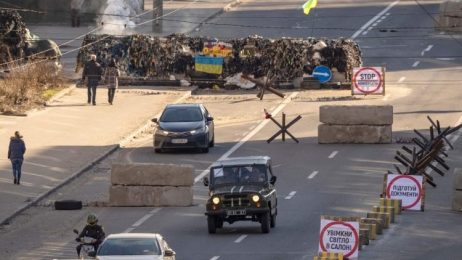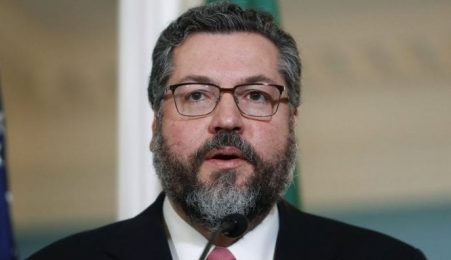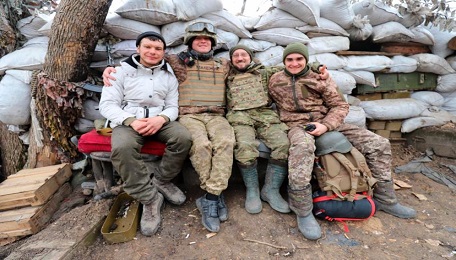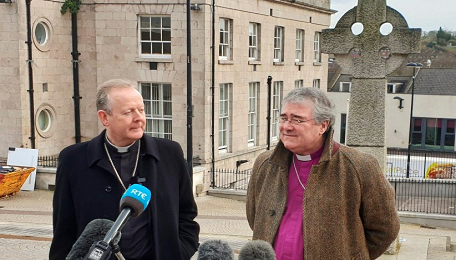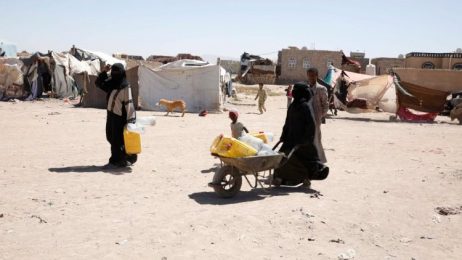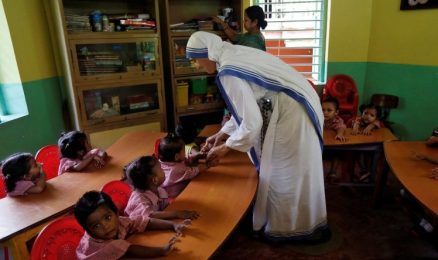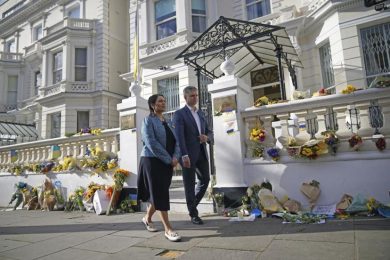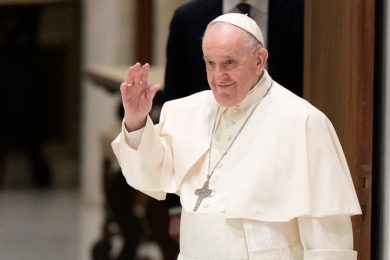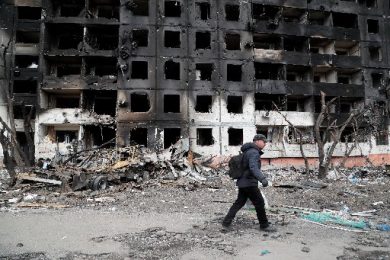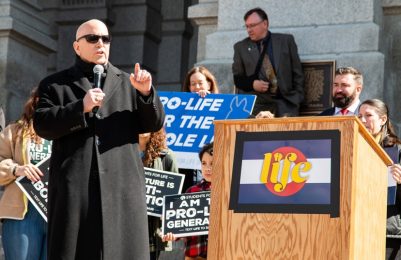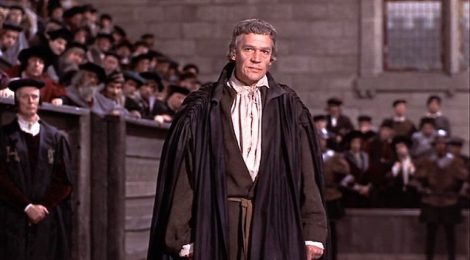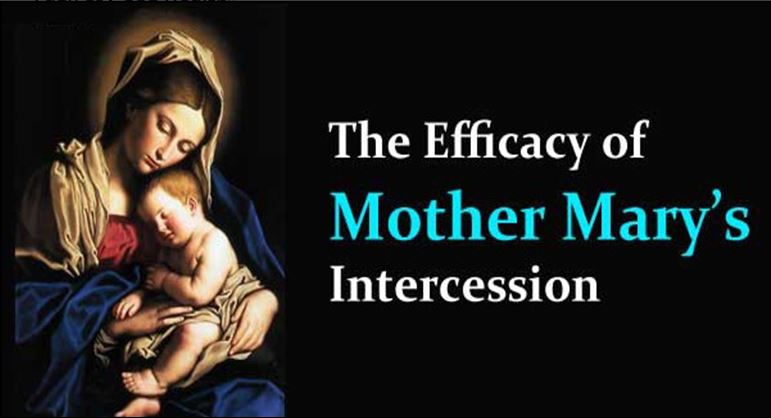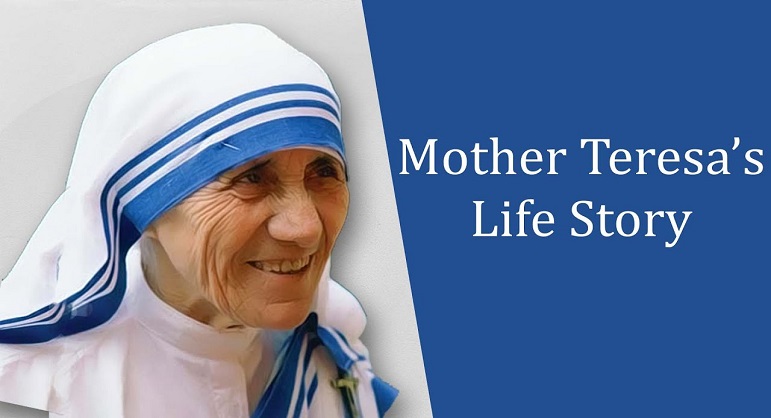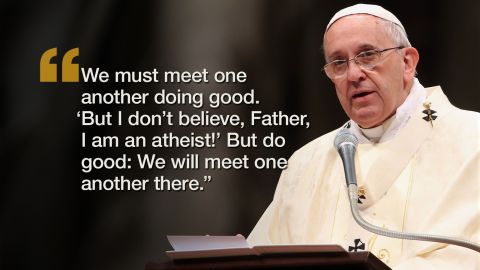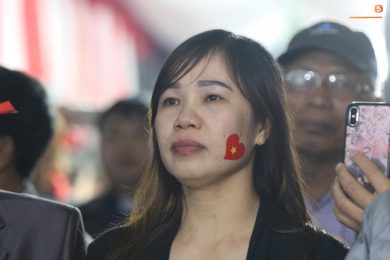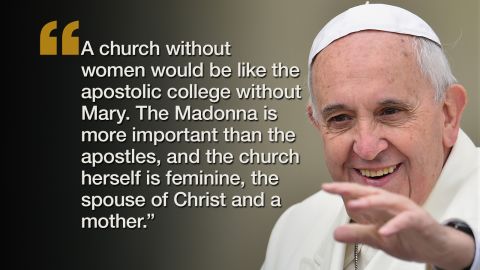CULTURAL
Pope writes his vision for the Church into new constitution for Roman Curia
(CGOL) Hailed in early news reports for its opening of top Vatican leadership roles to any baptized lay person, including women, the pope’s new document outlining the design and function of the Roman Curia enshrines much of Pope Francis’s broader vision for the church into the statutes of its governing body.

Pope Francis waves as he arrives for an audience with members of the members of the Antoniano children choir, at the Vatican, Saturday, March 19, 2022. (Credit: AP Photo/Andrew Medichini.)
In a new apostolic constitution published March 19 and titled Praedicate evangelium, or “Preach the Gospel,” the pope also created new mega-departments for evangelization and charity, taking personal charge of the former.
He has imposed strict term limits and now requires a certain level of pastoral experience for curial workers prior to their appointment. He has also placed significant emphasis on the curia’s relationship to national and regional bishops’ conferences, and is requiring regular departmental and inter-departmental meetings.
The product of nine years of work, the 54-page constitution was completed last year, but its publication has been several times delayed over what many observers believe was a lack of canonical precision in the largely pastoral document, which serves as a blueprint of Pope Francis’s vision for the universal church. It was released Saturday without any previous announcement, with no accompanying commentary, and exclusively in Italian. A Vatican news conference is scheduled for Monday.
Missionary Disciples
Since the beginning, the buzzwords of Francis’s reform have been evangelization, decentralization, and a missionary spirit. He prefers a curia that functions as an open, outward-reaching body that evangelizes through contact with local realities and closeness to the people, rather than an inward-looking entity, stuck and perpetually closed in on itself.
This spirit is emphasized in the preamble of the document, which states that preaching the Gospel “is the task that the Lord Jesus entrusted to his disciples,” and therefore, “the Church fulfills its mandate above all when it testifies, in words and deeds, the mercy that it freely received.”
Framed as part of the pope’s desire for a “missionary conversion,” the curial reform, according to the document, is intended to “better harmonize the daily exercise of the service of the Curia with the path of evangelization that the Church, above all at this time, is experiencing.”
As Francis has often repeated, the document insists that true reform is based above all on an “internal reform,” meaning personal conversion. The document stresses the link between mission and communion, especially among curial offices and local bishops.
It envisions a curia close and connected to local bishops by maintaining an “organic relationship” with national and regional bishops’ conferences, stating that, “The Roman Curia does not place itself between the Pope and the Bishops, rather it places itself at the service of both in the manner that is proper to the nature of each.”
The method for accomplishing this vision, for Francis, is “synodality,” allowing the curia, and the church as a whole, to become one “of mutual listening in which each one has something to learn.”
Noteworthy changes
With a new total of 16 departments, in addition to the various secretariats, tribunals, offices, and commissions, the number of Vatican offices has been reduced. Perhaps most noteworthy for many observers is the pope’s decision to create more space for lay people, including in positions of leadership.
To this end, the constitution states that “the pope, the bishops, and other ordained ministers are not the only evangelizers in the Church,” and because of this, the curial reform “must provide for the involvement of lay people, even in roles of government and responsibility.”
Calling the presence and contribution of lay people “essential,” the document says, “any member of the faithful can head a department or organism,” if the pope decides they are qualified and appoints them.
Whether or not the Vatican is able to attract senior-level lay people is yet to be seen, given that the pay is notoriously low, especially for workers who have to support families, and other issues, such as paternity leave for fathers, which was recently expanded from just one day to three.
Many of the other significant changes prescribed in the constitution have already been made, such as the merging of several offices of similar competencies into mega-departments, such as the departments for laity, family, and life, and the department for integral human development.
However, among the notable changes that have not yet taken place is the establishment of a new mega-department for evangelization which combines the former Congregation for the Evangelization of Peoples, also known as Propoganda Fidei, led by Filipino Cardinal Luis Tagle, and the Council for the New Evangelization, led by Italian Archbishop Rino Fisichella.
According to the constitution, this office will be presided over “directly by the Roman Pontiff,” which is notable since until now, no other department has ever been directly overseen by a pope per its statutes.
When Pope Francis created a department for integral human development, he announced that he would personally oversee the migrants and refugees section, which is run by two undersecretaries, but that his role would be temporary. No timeline was given, however, and he continues to oversee the section to this day. The new constitution did not specify leadership of the migrants and refugees section.
The new department for evangelization is divided into two sections, one of which deals with “the fundamental questions of evangelization in the world,” while the other is responsible “for the first evangelization and the new particular Churches in the territories of its competence.”
Unless Pope Francis appoints new leadership, it is likely Tagle and Fisichella will stay on, serving as heads of one of the two sections.
Francis also created a new mega-department for the service of charity, which is essentially a larger version of the papal almoner’s office. The pope’s current almoner, Polish Cardinal Konrad Krajewski, will likely take over this department.
According to the constitution, Service of Charity is “a special expression of mercy and, starting from the option for the poor, the vulnerable and the excluded, exercises in any part of the world the work of assistance and help towards them in the name of the Roman Pontiff, who in cases of particular poverty or other need, personally disposes the aid to be allocated.”
The top three departments, now to be called “dicasteries” under the new curial structure are: Evangelization, the Doctrine of the Faith (CDF), and the Service of Charity, in that order. Most other departments remain the same.
Another significant change is incorporating the Pontifical Commission for the Protection of Minors into the curia as an independent office within the CDF, which will continue to operate with its own rules and its own president and secretary.
In a statement Saturday, American Cardinal Sean O’Malley of Boston, who oversees the commission, praised the decision to incorporate it into the CDF, saying, “For the first time, Pope Francis has made safeguarding and the protection of minors a fundamental part of the structure of the Church’s central government.”
At the same time, by maintaining its autonomy as a separate body within the CDF, which enjoys direct contact with the pope, the commission, O’Malley said, “will play an increasingly incisive role in ensuring the Church is a safe place for children and vulnerable persons.”
In the past, there have been complaints that suggestions made by the commission to Vatican departments have fallen on deaf ears, that they have been met with resistance, or thwarted in some way. With the commission now being part of the curia itself, the hope, among observers, is that the body’s recommendations will be taken more seriously and receive a more responsive reception.
One thing that has not changed is that the Secretariat of State, defined in the document as a “papal secretariat,” remains the driving force within the curia. Given recent scandals, and after the pope took away the Secretariat’s hold on the Vatican’s purse strings, there had been some speculation that the reforms would further clip its wings.
Cooperation and turnaround
For decades, the curia has been seen as a disorganized and dysfunctional body, where members of the same department hardly knew each other, let alone members of other departments, and where a lack of internal cooperation and coordination was notoriously a recipe for basic mistakes, a chronic lack of motivation, and simply not getting things done.
The curia has also long been seen as a place where pastoral drive goes to die, as priests often get stuck in their Vatican gigs for decades, having little to no pastoral experience at all. Some get lost in the inner workings of the Vatican’s bureaucratic machine while others attempt to climb the ladder to more prominent positions in and around the Vatican curia.
In moves largely aimed at combatting this cycle of dysfunction, apathy, and careerism, Pope Francis has implemented several changes, requiring regular departmental meetings and imposing strict term limits for curial officials.
Among other things, the pope takes aim at what many observers have claimed over the years is a lack of spirituality in the curia and stresses the importance of fostering a stronger spiritual environment within curial departments through moments of common prayer and spiritual renewal, and the periodic celebration of Mass for department members.
To ensure greater levels of competence, the pope stressed the importance of professionalism on the part of those who are employed in the curia, insisting that more “careful attention” be devoted to the selection and training of staff.
To this end, the constitution states that “it is indispensable that, beyond dedication and righteousness, those who work are qualified.”
It also emphasized the need to pay more heed to how departmental work is organized and the ongoing professional development of curial employees.
Curial officials, the constitution says, are to be selected “according to objective and transparency criteria” and must have “an adequate number of years of experience in pastoral activities” before their appointment, although it does not specify how much pastoral experience is needed.
In the spirit of fostering greater communion and collaboration, the document stipulates that department heads are to meet periodically with the pope for both individual and joint meetings, to promote transparency and “concerted action” on the department’s plans, and their application.
According to previous custom, only the heads of the CDF and the Congregation for Bishops met with the pope on a regular, weekly basis. Under the new rules, it is expected that the number of the pope’s meetings with department heads will increase.
Francis also called for regular meetings with department heads where issues involving several departments can be jointly discussed. These meetings are to be arranged by the Secretary of State in accord with the pope.
Regular meetings within each department are now also required, such as plenaries, councils, and congresses.
Specifically, the constitution requests that ordinary sessions be organized regularly for resident members of departments, and that plenary sessions including all members be held every two years, using video conferences and calls when necessary. Department consultors may also be called in as needed.
At the close of these ordinary and plenary meetings, a general document summarizing the discussion will be drafted and sent to the pope and other departments involved in the matter discussed for observations and recommendations. Any major decision or resolution must be approved by the pope directly.
The constitution requires that department officials must be, to the extent possible, from different parts of the world so that the curia “reflects the universality of the Church.”
In terms of employee turnover, Pope Francis set a five-year term limit for department prefects, secretaries, undersecretaries, and other major officials. Lower-level officials also have a mandate of five years, after which they are required to return to their dioceses or religious institute.
These mandates can be extended if the pope deems it necessary. How strictly these mandates will be enforced is yet to be seen, but the decision specifically to send clerical officials back to their dioceses is likely a move to prevent priests from becoming mere “functionaries” and “careerists” in the curia.
Priests and bishops who have worked in Vatican departments sometimes have no desire to return to diocesan work once their mandate is up, especially those from so-called missionary countries, despite growing priest shortages and a need for pastoral relief.
By CRUX staff reporter
(CGOL) O Trinity, we bless you because from all eternity you have chosen Mary to be the mother of the...
(CGOL) Taking care of the elderly, sick and infirm is always a difficult job, even a burden for many people....
(CGOL) A priest in Guinea-Bissau has received death threats after he posted critical comments about President Umaro Sissoco Embaló on...
(CGOL) Argentina – The northern Argentine city of Ingeniero Juarez, in the province of Formosa, is known for being hot...
(CGOL) A Christian with a mature conscience, in moral discernment, needs to understand the various aspects of the matter rather...
(CGOL) The Bishops of the United States respond to reports of increasing incidents of church vandalism and fires, and urge...
(CGOL) After nearly a decade of being caught in the middle of Syria’s bloody civil war, Christians in the country...
(CGOL) Ohio - One month after a major pan-African summit wrapped up in Nigeria, Ugandan missionary priest Father Ruffino Ezama...
(CGOL) Đức Hồng Y Luis Antonio Tagle của Manila đã đọc một bài giảng trong một thánh lễ trước khi...
(CGOL) In the Gospel (Luke 7:28), Jesus said to the crowd: "There is no one greater among men born of...
(CGOL)In his Christmas message issued on January 6, the head of the Ethiopian Bishops' Conference asks the faithfull to ask...
(CGOL) During his installation in the capital Lomé, Togo’s newest archbishop called on presidential candidates to be “servants of the...
(CGOL) With the start of the new year, a seasoned Philadelphia musician is taking on a new challenge as director...
(CGOL) Most Christians would agree it is wrong to hate someone, but it is also wrong to be indifferent, which...
(CGOL) British Cardinal Vincent Nichols is calling on the government of Prime Minister Boris Johnson to allow Ukrainian refugees “to...
(CGOL) Hailed in early news reports for its opening of top Vatican leadership roles to any baptized lay person, including...
(CGOL) A Ukrainian priest described escaping from his bombed-out parish in Mariupol and said he still hopes some Catholics will...
(CGOL) Testifying against legislation that would codify a right to an abortion into Colorado law, Archbishop Samuel Aquila of Denver...
(CGOL) In 2014, I published a list of ‘100 Best Catholic Movies.’ Below I have arranged the list not by...



